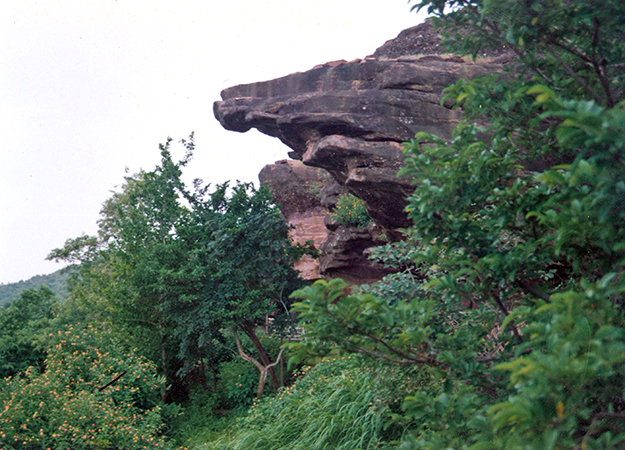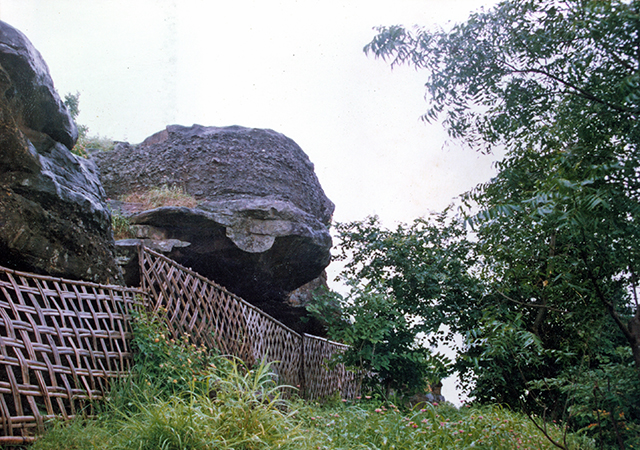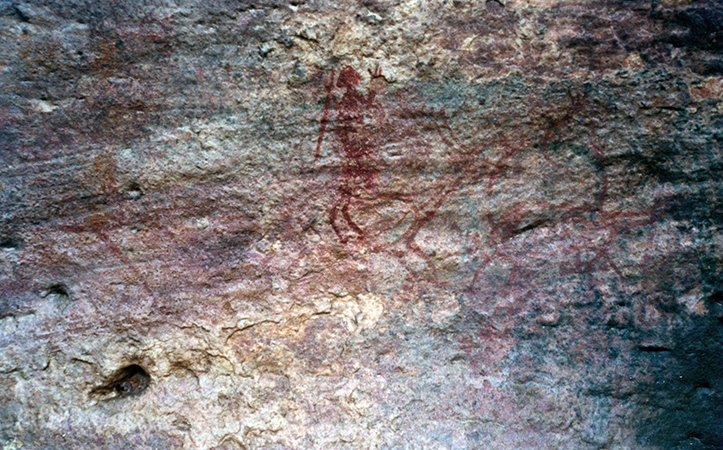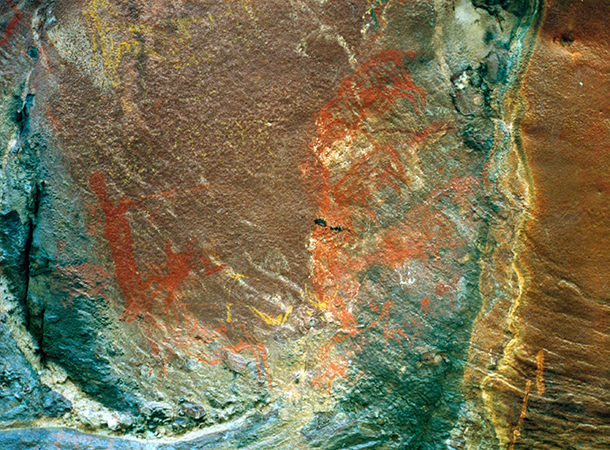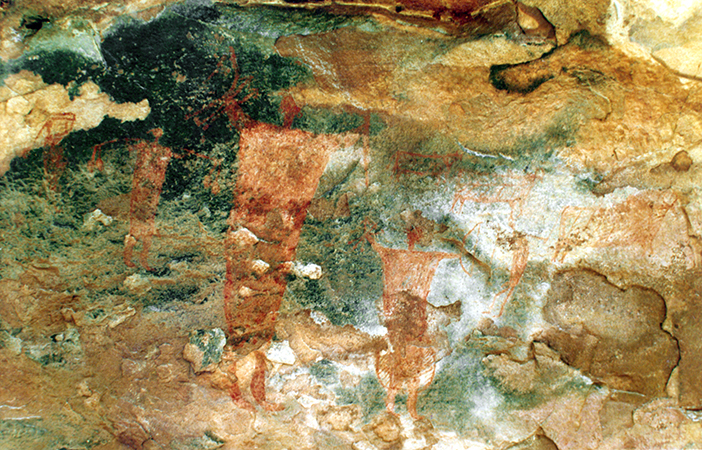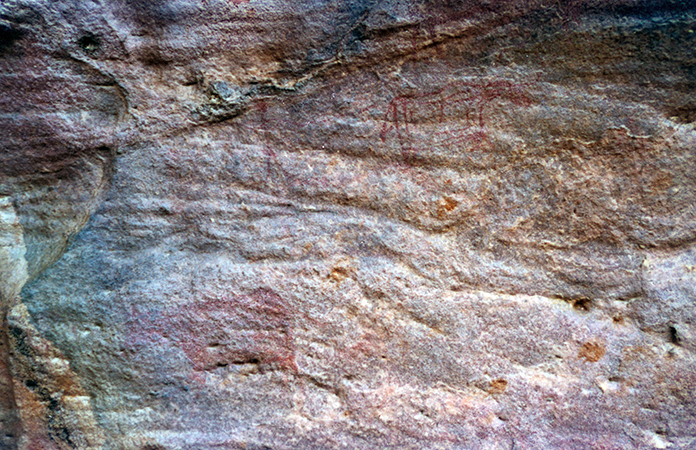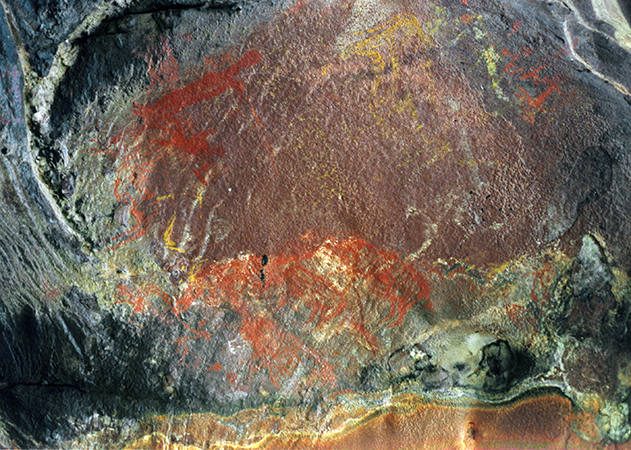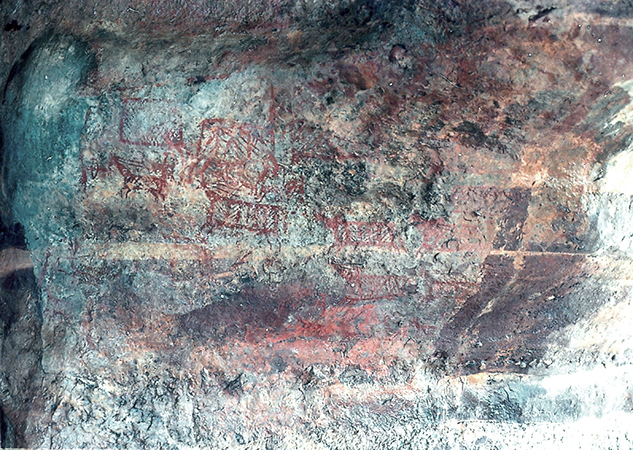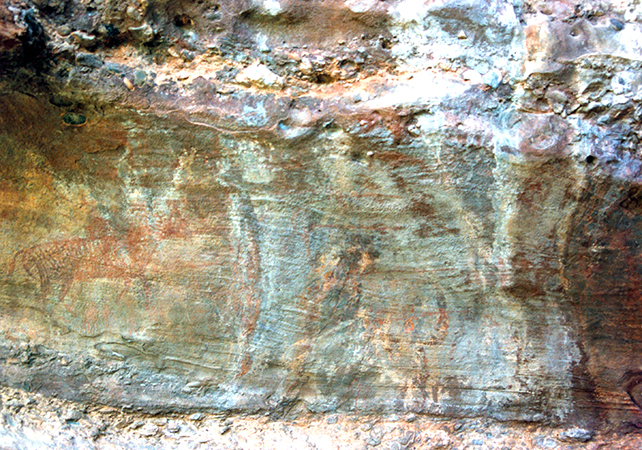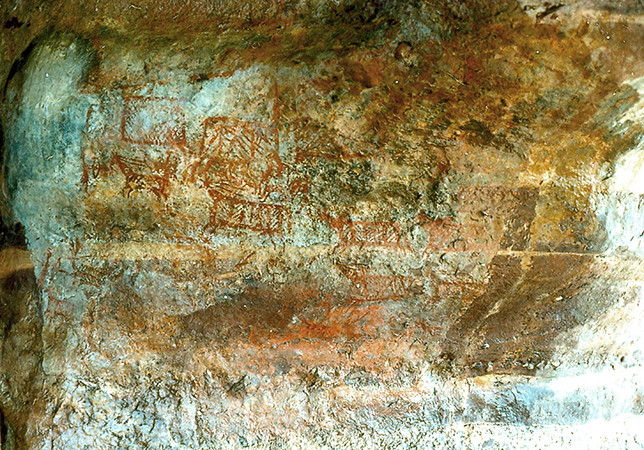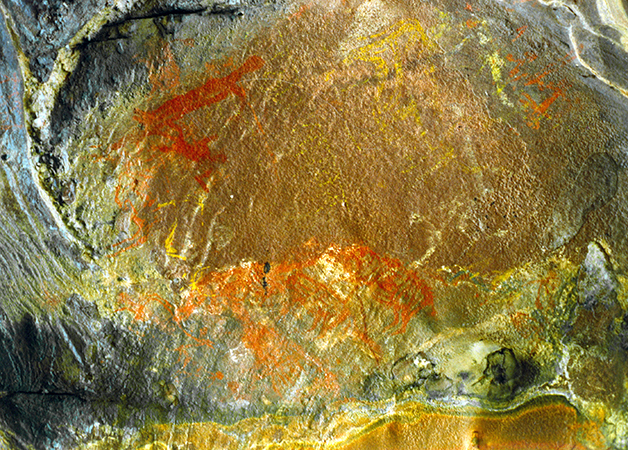शैलकला धरोहर – मुक्ताकाश प्रदर्शनी
विश्व व्यापी रूप से उपलब्ध ‘शैलकला अपने सौंदर्य तत्व, विविधता और सहजता के कारण प्रथम दर्शन से ही मनोहारी और आकर्षक लगती है। संबंधों की दृष्टि से वह प्रत्येक मनुष्य के अतीत से सीधे जुडी है भेले ही लोग इससे अनभिज्ञ हों।
अधिकांशतः शैलकला स्थल दूरदराज के बीहडों व दुर्गम क्षेत्रों में होते हैं। कला की परिधि से बाहर जाकर भी रची गयी पुरातन शैलकला को पूर्णतः समझ पाना यद्यपि अब तक संभव नहीं हो पाया है, यह सर्वमान्य अनुमान है कि इसके अर्थ काफी व्यापक रहे होंगे। शैलकला दर्शन, आनंद के साथ साथ बौद्धिक चुनौतियां भी देता है।
भारतीय भूक्षेत्र में उपलब्ध ‘शैलकला का अद्वितीय महत्व है क्योंकि इस क्षेत्र में सांस्कृतिक परंपराओं की निरंतरता से बनी अनूठी और गौरवपूर्ण स्थिति में आज भी विद्यमान है। इससे आधुनिक भारतीय संस्कृति में ‘शैलकला की धरोहर के रूप में स्थान स्वाभाविकतः उपलब्ध है।
‘शैलकला संपदा ऐसी अनूठी सांस्कृतिक धरोहर है जो मनुष्य के सांस्कृतिक उदविकास की प्रागैतिहासिक गाथा का अभिन्न अंग है। आरंभिक शैलकला उस समय रची गयी जब दुनिया आज जैसी जटिल राजनैतिक भूगोल में विभाजित नही थी। तब प्राकृतिक अवरोध तो थे लेकिन देश राज्य आदि नहीं थे, मनुष्य यायावर, शिकारी संग्राहक जीवन जीता था, खेती की संभावनाओं को उसने कहीं भी आजमाया नहीं था। उस समय गांव नहीं थे, आबादियां शायद पशु एवं वनस्पति बहुल वातावरण में घुमंतु टोलों में रहती थी। लेकिन उस समय सांस्कृतिक विविधतापूर्ण प्रभावी एवं संपन्न थी, लोग परिश्रमी और चिंतनशील थे। वे शारीरिक रूप से आधुनिक थे।
अंतिम हिमयुग समाप्ति पर था, बहुत ठंडी जगहों से बर्फ हट रही थी, और नयी वनस्पति पनपने लगी थीं। मध्य भारत क्षेत्र में तब निष्चित ही तापक्रम आज से कुछ कम और वनस्पतियां खूब रही होंगी। उनमें वे पशु प्रजातियां भी रहती होंगी जिनके इस क्षेत्र से कालान्तर में बिल्कुल विलुप्त हो जाने से आज हम उनकी अनुपस्थिति के आदी बन चुके हैं।
डस समय रची गयी कला किन्हीं अर्थों में संपूर्ण मानवता से संबंधित हैं, उस पर देशों के स्वामित्व तत्संबंधित संस्कृतियों के लुप्त हो जाने के काफी बाद स्थापित हुये हैं। ऐसी कला जबाब वह आज की संस्कृतियों द्वारा आत्मसात किये जाने पर उसका अंग बनती जा रही है, भिन्न आधुनिक संस्कृतियों और समाजों को, मानवता के समग्र धरातल पर एक सूत्र में जोडती हैं। शैलकला संपूर्ण मानवता को उपलब्ध उसकी सांस्कृतिक धरोहर है जिसे उत्तराधिकार स्वरूप अक्षुण्य अवस्था में आने वाली पीढियों को सौंपा जाना है।
हजारों वर्षों से सलामत शैलकला धरोहर पिछले कुछ दषकों से मानव गतिविधियों में अपूर्व वृद्धि के कारण ऐकाएक संरक्षण की ऐसी नाजुक स्थिति में आती जा रही है कि उसे सप्रत्यन ही बचाया जा सकता है। नुकसान मुख्यतः अनभिज्ञता तथा अज्ञानतावश किये गये मानव व्यवहार से हुआ है जिसमें आगे निपटने का एक सर्वउपयोगी उपाय, इस धरोहर के संबंध में संपूर्ण जानकारी के संचार से उसे सम्मान लौटाना ही है। चूंकि शैलकला विषय पर जानकारी एकत्रण और प्रलेखन कार्य अनेक दृष्टिकोणों से सामान्य सूझबूझ और विकसित रूचि एवं ज्ञान के आधर पर जन साधारण के सक्रिय सहयोग से संभव है, अनेक देषों में लोगों ने इसे अतिरिक्त रूचि क्षेत्र के रूप में अपनाया है। अज्ञात की खोज में निहित चुनौती तथा उसका आनंद भारत में भी लोगों को शैलकला की ओर आकर्षित करता रहा है। ‘शैलकला पर अधिक स्पष्ट जानकारी की निरंतर वृद्धि उसमें अनेक वैज्ञानिक विषयों की बढती रूचि के कारण संभव हो रही है।
सामान्य दर्शक की वैयक्तिक रूचि का क्षेत्र कुछ भी हो, सभी को शैलकला का सौंदर्य एवं उसकी विषयवस्तु में उपलब्ध चुनौतीपूर्ण प्रश्न बौद्धिक धरातल पर कुछ न कुछ आनंद के अलावा भी अवष्य प्रस्तुत करते हैं।
शैलकला का मानवशास्त्रीय महत्वः
चूंकि मानवशास्त्र मनुष्य का उसकी समग्रता से अध्ययन करता है और मानव उदविकास, संस्कृति एवं समाज के अध्ययन उसके पारंपरिक विषयक्षेत्र हैं, शैलकला की उपलब्धि इस विषय के लिए महत्वपूर्ण है। इस पुरातन कला को मानवशास्त्री प्राचीन जनसंख्याओं की भौतिक संस्कृति और उनके द्वारा पीछे छोडे गये सांस्कृतिक संदेशों के रूप में मानते हैं। इनके अध्ययन से न केवल पुरातव जनसंख्याओं की जीवनश्षैली मानसिकता, रीतिरिवाज, लोकाचार और विष्वबोध की जानकारी जुडती है बल्कि आधुनिक युग के लोक समाजों, और संस्कृतियों के लिए अपेक्षाकृत अधिक व्यापक वैज्ञानिक आधार भी तैयार होता है।
संग्रहालय परिसर में शैलकला स्थल
शैलकला भौतिक संस्कृति की वस्तु तो है किंतु संग्रह कर उसे संग्रहालयों में रखा नहीं जा सकता। देखने के लिए शैलाश्रय के परिप्रेक्ष्य में उसकी मौजूदगी वैसे भी दर्शक की दृष्टि से सबसे बेहतर स्थिति है। यह सौभाग्य है कि इस संग्रहालय के परिसर में शैलाश्रय मौजूद हैं।
संग्रहालय परिसर में चार समूहों में शैलाश्रय उपलब्ध हैं। प्रेमपुरा पहाडी पर 5, रीजनल कालेज के पीछे स्थित दो सूहों में 18, पूर्व की ओर स्थित नाले अतिथि गृह के पास 2 चित्रित षैलाश्रय हैं। प्रदर्षनी के वर्तमान चरण में रीलनज कालेज के पीछे स्थित एक समूह के 11 शैलाश्रयों को शामिल किया गया है। इन समूहों के चित्रों की अपनी अपनी परस्पर भिन्न विषेषताऐं हैं तथापि वे क्षेत्र के अन्य स्थलों से किन्हीं मायनों में साम्य रखते हैं, संबंधित हैं।
शहर के नजदीक होने के कारा, पिछले दषकों में लोगों के निरंतर इस स्थल पर आवागमन तथा जंगलों के नष्ट होने के कारण चित्रों के संरक्षण की स्थिति में बहुत गिरावट आई मालूम पडती है। अनेक स्थानों पर चित्र वर्षा, धूप व हवा की मार से लगभग मिट चुकी अवस्था में पहुंच गये हैं। चट्टानों की उपरी सतह जिस पर चित्रांकन किया गया था, अच्छी अवस्था में नहीं है। इससे अनेक चित्र जिनका संयोजनों में महत्व रहा होगा, अब केवल आंशिक रूप से ही उपलब्ध रह गये हैं। अन्य स्थलां की तरह इस स्थल पर भी एक दूसरे पर चित्रांकन किये गये हैं। अतः एक ही स्थान पर चित्रों की चार पांच सतहें मिलना सामान्य है। सबसे निचली पर सर्वाधिक पुराने चित्र हरे रंग में, अपेक्षाकृत बडे आकारों में बनाये गये थे उनके आभास मात्र ही बचे खुचे हरे रंग के धब्बों में मिलते हे।इस कारण, सतह दर सतह चित्रों को अध्ययन के लिए परस्पर अलग करने में बहुत सफलता नहीं मिल पाती है।
प्रस्तुतिकरण
इंदिरा गांधी राष्ट्रीय मानव संग्रहालय द्वारा आयोजित ‘शैलकला विरासत प्रदर्शनी में प्रस्तुतिकरण दो भागों मं किया गया हैं पहले अंतरंग हिस्ससे में शैलकला विषय का परिचय तथाउसमें उपलब्ध विविधता अनेक स्थलों में उपलब्ध चित्रों में से नमूने लेकर प्रस्तुत है। दूसरे हिस्से में संग्रहालय परिसर में उपस्थित मूल चित्र षैलाश्रयों की प्रस्तुति में अनेक तरह से चित्रों को समझने के लिए प्रादर्षों के माध्यम से दर्षक को सहायता उपलब्ध कराई गयी है।
शैलाश्रयों के उपयोगः चित्रों के पुरातव संबंध मुख्यतः शिकारी आखेटक जनसंख्याओं तथा पशुओं के पालतूकरण से जुडी अथवा पशु पालक जनसंख्याओं से है जो क्रमशः मध्य पाषाणकाल तथा ताम्र पाषाण काल से संबंधित प्रतीत होते है। उनमें मानव आकृतियां, पशुओं तथा उनके आपसी संबंध को प्रतिबिम्बित करने वाले संयोजनों की विषयवस्तु के आधार पर सोचा जा सकता है कि शैलाश्रयों का उपयोग भिन्न समयों में परस्पर भिन्न संस्कृतियों द्वारा अलग अलग सांस्कृतिक अभिप्रायों से किया गया था। प्राचीन काल में उपयोगकर्ता को इस स्थल से दूर तक का नजारा दिखाई देता होगा। लेकिन शैलाश्रय निरंतर रहने का स्थान रहे हों ऐसा स्पष्ट प्रमाण से मालूम नहीं पतडता। संभवतः कुछ शैलाश्रयों को अनुष्ठानिक कार्यों के अभिप्राय से प्राथमिकता दी जाती रही होगी, यह अवश्य इन शैलाश्रयों में से प्रत्येक में किन्ही वृहद विषयवस्तु से अधिकांष चित्रों के संबंधित होने के आधार पर कहा जा सकता है। वृहद विषयों जैसे सामूहिक गतिविधि, धार्मिक अनुष्ठानिक आदि के अंतर्गत लधु प्रसंग कहीं कही परस्पर संबंधित तो हैं, लेकिन शैलीगत भिन्नता संजोये हुए हैं। दूसरी ओर, किन्ही शैलाश्रयों में पशुओं, मनुष्यों की आकृतियों के चित्र संयोजनों में आयोजित न होकर अधिकांशत एकाकी है। ऐसे चित्रणों में अभिप्राय सामूहिक भावना नहीं बल्कि वैयक्तिक मालूम पडते हैं।
शैलाश्रयों का संबध ऐसी जनसंख्याओं से रहा है जो सूक्ष्म पाषाण उपकरणों का उपयोग करती थीं। यह शैलाश्रयों से ऐसे उपकरणों की उपलब्धि के स्पष्ट है। इसी स्थल में काफी पहले के समयों के दौरान पुरापाषाण कालीन उपकरणों का उपयोग करने वाली जनसंख्याऐं उपस्थित रही होंगी। इस धरातल से ऐसे उपकरणों की प्राप्ति के आधार पर अनुमानित है। यह मानव की उपस्थिति की निरंतरता की ओर एक संकेत है। इस स्थल के चित्र आसपास स्थित अन्य स्थलों के चित्रों से बहुत कुछ मिलते जुलते हैं जिससे यहां उपस्थित रही जनंसख्याओं के वहां आने जाने की प्रवृत्ति इंगित होती है।
शैलाश्रयों की जमावट भू रचना के दो स्तरों में है। शैलाश्रय कांगलोमरेट या बलुआ चटटानों में नैसर्गिक रूप से बने हैं। यहां कभी घना वन रहा होगा और उसमें जंगली पशु ओं की उपलब्धता रही होगी। लगभग एक दषक पूर्व तक जंगली सुअर व अभी भी साही जैसे पशु ओं की उपस्थिति रही है। निष्चित ही जिस समय प्रारंभिक चित्रकला की रचना हुई, मौसम आज से काफी भिन्न ही होगा। गैंडा तो आजकल इस क्षेत्र में नही मिलता उस समय आसपास उपलब्ध रहा होगा। यह षैलाश्रय क्रमांक 17 के एक चित्र से पता चलता है।
अनुष्ठानिक महत्वः
शैलाश्रय क्र 22 में मुखौटाधारी मानव आकृतियां और भिन्न गतिविधियों मं संलग्न स्त्रियों के चित्र उपलब्ध हैं। ये भिन्न शैलियों में अंकित होने के कारण परस्पर भिन्न जनसंख्याओं से संबंधित माने जा सकते हैं। आरंभिक चित्रकला में मानव आकृतियां लकीरों से निर्मित हैं। पुरूष आकृतियां अतिरंजित लंबाई लिये हुए लकीरों में निर्मित हैं लेकिन मोटाई में अंकित स्त्रियां अपेक्षाकृत ठिगनी दिखाई गयी हैं। शैलाश्रय क्र 21 में मानव आकृतियां किसी नृत्य की मुद्रा मं समूह में एक दूसरे से जुडी हुई अंकित हैं। इसी षैलाश्रय में एक स्त्री (संभवतः गर्भवती) का चित्र दो अन्य सहायक पशु आकृतियों के साथ है।
इस शैलाश्रय में पशुओं के चित्र एकाकी हैं कहीं भी शिकार करने की अवस्था चित्रित नहीं दिखाई देती। लगता है जैसे शैलाश्रय का उपयोग ऐसे प्रयोजन के लिए तथा उससे जुडे अभिप्राय व्यक्त करने के लिए किया होगा, जिसमें स्त्रियों की स्थिति पुरूष से गौण लेकिन समूह के लिए प्रकार्यात्म्क रूप से अवश्य महत्वपूर्ण रही होगी।
इसी शैलाश्रय में 75 ऐसी मानव आकृतियां हैं जो भिन्न गतिशील मुद्राओं में चित्रांकित है उसमें लिंग संबंधी विभेद हलांकि दिखाई नहीं देता तथापि कहा जा सकता है कि इस शैलाश्रय का संबंध किसी ऐसी सामूहिक तिविधि से रहा होगा जिसमें नृत्य तथा उन्माद की स्थितियां बनती होंगी। मानव आकृतियां काफी छोटे आकार के होने से लगता है कि व्यक्ति की तुलना में समूह का महत्व उस अवस्था में अधिक रहा होगा। यह ऐसी कोई अनुष्ठानिक गतिविधि होगी जिसका मौसम से संबंध था। इसी शैलाश्रय में एक चित्र मं मोर को पंख फैलाये दिखाया गया है। जैसा कि बरसात की शुरूआत में देख जाता हैं संभव है कि सामूहिक गतिविधि का संबंध भी इसी मौसम के किसी अनुष्ठान से रहा हो।
निचली छत होने के कारण शैलाश्रय में ऐसी जगह नहीं कि बैठकर चित्रों को देखा जा सके, लेटकर देखना सुविधाजनक होता है। छत पर एक बडा हिरण चित्रित है। कुछ शैलाश्रयों में चित्रों की इसी तरह कीस्थिति देखकर सोचा जा सकता है कि क्या एकाकी पशुओं के चित्र किसी अभिप्राय से उन्हें नजरों से छुपाने, शैलाश्रय के ऐसे स्थानों पर चित्रांकित किये जाते थे कि वे एकदम सामने न पडते हों। तत्संबंध में बस्तर की एक जनजाति के वर्षाकालीन अनुष्ठान की चर्चा यहा प्रासंगिक है। यह अनुष्ठान वन देवताओं को प्रसनन करने के लिए होता है। इसके होने की जानकारी केवल गोत्र के लोगों को ही होती है और वहां गांव के अन्य लोगों के लिए एक सीमा के आगे आना वर्जित होता है। इसी तरह की कोई परंपरा प्रागैतिहासिक जनसंख्या के बीच भी होना संभवित है।
चित्रित मानव आकृतियों में कमर के नीचे आच्छादन, मुखैाटे व सिरों आगारों में विविधता यह दर्शाती है कि इन आरंभिक चित्रों की निर्माणक जनसंख्याओं के लिए अपनी पहचान महत्वपूर्ण रही होगी। किन्हीं प्रयोजनों से वे इस क्षेत्र में एक ही समय उपस्थित रही होंगी। ऐसी स्थिति में पहचान चिन्हों के अंकन का सामुदायिक महत्व रहा होगा। क्या वे जनसंख्याऐं गोदना, शरीर रंगने जैसे तरीके भी इस्तेमाल करतीं थी जैसा कि किन्हीं जनजातियों में देखा जाता है चित्र में कहीं भी आगे स्पष्ट नहीं। लेकिन इस दिशा में प्रति परीक्षण उपयोगी हो सकता है।
अधिकांश चित्र लाल रंग के अनेक किस्मों तथा सफेद रंग के हैं। पीले रंग के चित्र शैलाश्रय क्र 23 एवं15 में है जबकि हरे रंग के चित्र सबसे निचली सतह से अस्पष्ट रूप से कई शैलाश्रयों में उपलब्ध है।
शैलाश्रयों से शिकार संबंधी जानकारीः
यदयपि दूसरे शैलाश्रयों में भी शिकार से संबंधित चित्र है, शैलाश्रय क्र 16 में अंकित चित्र अपनी सुस्पष्टता और हथियारों के प्रकार के लिए विशेष उल्लेखनीय एक संयोजन में 5 बारहसिंगों और दो वनभैंसों की आकृतियों के बीच एक मुखौटाधारी शिकारी चित्रित है जिसके एक हाथ में धनुष और दूसरे हाथ में तीर है जिनके फल सूक्ष्म पाषाण उपकरणों को फंसाकर बनाये गये प्रतीत होते हैं, षिकारी की दोनों हाथों में एक समान स्थिति पर आभूषण है। कम के नीचे लटकता कोई वस्त्र या आच्छादन है। आभूषणों की स्थिति व सजावट के साथ पशु ओं के बीच एकाकी मानव को देखकर लगता है कि उससे किसी विषिष्ट व्यक्ति या नायक का अभिप्राय रहा होगा। यह चित्र शिकार या पशु संपदा से संबंधित किसी ऐसे अनुष्ठान के अवसर पर चित्रित किया गया हो सकता है जिसमें नायक या समरूपी दैविक शक्ति का महत्व हो।
शैलाश्रय 18 में बडी संख्या मे पशुओं के अपेक्षाकृत बडे चित्र लगभग सारी छत पर अंकित हैं जिनमें से अधिकांष काली परत जम जाने के कारण धुंधले दिखाई देते हैं संख्या में एक ही जगह पशु अधिक होने के बावजूद पशु आकृतियां संबंध के लिए एक दूसरे से जुडी दिखाई नहीं दती। यहीं एक मानव आकृति को कंधे पर रखी लकडी अथवा कांवर में कुछ कंद टांगे हुए दर्शाया गया है। जिसका संबंध संग्रहण से है। पशुओं की उपस्थिति मात्र संग्रहण स्थल के पर्यावरण को दर्शाने के लिए है। इसी शैलाश्रय में दूसरी शैली और बाद के चाल्कोलिथिक एक संयोजन में दो मानव आकृतियों को अलग अलग स्थानों पर तीर से शिकार करते हुए दिखाया गया हैं जिन्हें मुखौटों सींगो वाले मानव के आधार पर एक अलग जनंसख्या या संस्कृति से संबंधित माना जा सकता है।
कर्मकाण्डः शैलाश्रय क्र 15 के एक स्थान पर अलगअलग संयोजन में एक ही विषय वस्तु की तीन बार आवृत्ति है। उनमें एक मानव आकृति खडी अवस्था में और उसकेा काटती दूसी आकृति जमीन पर पडी हुई अवस्था में दर्शायी गयी है। पास में एक अन्य मानव आकृति, अपेक्षाकृत ठिगनी, खडी अवस्था में मौजूद है। लगता है जैसे जीवित व्यक्ति खडा व मृत व्यक्ति का शरीर जमीन पर पडा हुआ हो। तीनों संयोजन एक जैसी शैली में है। चित्र का अभिप्राय मृत्यु अथवा मृतक से संबंधित कोई कर्मकाण्ड प्रतीत होता है।
शैलाश्रय क्र 12 के चित्र धातुयुगीन हैं। यह इस आधार पर सहजतः कहा जाता है कि दर्शित मानवों के हाथों में धातुफलक युक्त तीर हैं। संग्रहित वस्तुओं को लटकाकर एक साथ कहीं ले जाते हुए दर्शित किया गया है। पास में एक मानव आकृति को कुबडी गाय की पूंछ पकडे दिखाया गया है। विषय वस्तु के आधार पर चित्र को पशु पालक जनसंख्या से संबंधित माना जा सकता है जिसमें छल्लेदार आभूषण पहनते थे, सिर पर किसी तरह का मुकुट और किसी तरह के वस्त्र भी धारण करते थे।
चित्र का संबंध किसी वैदिक अवधारणा या उस पर आधारित कोई अनुष्ठानिक कर्मकांड से प्रतीत होता है। तत्संबंध में दो संभावनाऐं व्यक्त की जा सकती है। जैसे कि समूह के कोई महत्वपूर्ण गौरवशाली सदस्य के तीर्थ यात्रा पर निकलने, जिसके दौरान उसके तीर्थ जाकर वैतरणी पार करने का विचार हो। दूसरे मरोणोपरांत व्यक्ति की आत्म को वेतरणी पार कराने की सामुदायिक कोशिश हो। यह इस आधार पर कहा जाता है कि आगे चित्रित पुरूष को गौरवशाली प्रतिष्ठित छवि प्रस्तुत की गई हे पास की दूसरी आकृति में जैसे विचार में महसूस किया जा रहा है कि वह गाय की पूंछ का छोर पकडकर वैतरणी पार कर रहा हो। मृत्यु से संबंधित कर्यमें परंपरागत रूप से आज भी अवधारणा एवं कर्मकांड के रूप में यह व्यवहार प्रदर्षित है।
Rock Art Heritage – Open Air Exhibition
Widely available Rock Art, due to its aesthetic element, variety and ease, looks beautiful and attractive at the very first sight. From the point of view of relations, it is directly related to the past of every human being, even if people are unaware of it.
Most of the rock art sites are in remote and inaccessible areas. Although it has not been possible to fully understand the ancient rock art created even outside the purview of art, it is a widely accepted assumption that its meaning must have been very wide. Watching the Rock art gives pleasure as well as intellectual challenges.
The rock art available in the Indian territory has an unparalleled importance because it is still present in a unique and proud condition created by the continuity of cultural traditions in this region. Due to this, it (Rock Art) has got a material status of heritage in modern Indian culture.
Rock art is such a unique cultural heritage that is an integral part of the prehistoric story of the cultural evolution of mankind. Early rock art was created at a time when the world was not as divided in the complex political boundaries as today. Although there were natural barriers but there were no countries, states etc. Man lived the life of a hunter-gatherer, he did not try the possibilities of farming anywhere. At that time there were no villages, the populations were probably nomads and settlements where in an environment dominated by animals and full of vegetation. But at that time cultural diversity was dominant and rich.
The last ice age was at its end, snow was being removed from very cold places, and new vegetation was beginning to grow. In the Central India region, then certainly the temperature would have been a little lower than today and there would have been plenty of vegetation. Those animal species would also have lived in them, due to which we have become accustomed to their absence today due to their complete extinction from this area. Those animal species would also lived here of which we have gone accustom just due to their long absence.
The art created then is in some sense related to the entire humanity, the ownership of which has been established long after the respective cultures have disappeared. Such an art is becoming part of it as it is assimilated by today’s cultures, connecting different modern cultures and societies into a single thread on the basement of humanity. Rock art is its cultural heritage available to the entire humanity, which is to be handed over to the coming generations in an intact state as a succession.
Due to the unprecedented increase in human activities over the past few decades, the rock art heritage, which has been preserved for thousands of years, is suddenly coming in such a critical state of conservation that it can only be saved. The damage is mainly caused by ignorance and ignorant human behavior, in which an short sure solution is to deal further, is to return the respect to this heritage through communication of complete information. Since information gathering and documentation work on the subject of rock art is possible with the active cooperation of the general public on the basis of common sense and developed interest and knowledge from many perspectives, people in many countries have adopted it as an additional area of interest. The challenge and joy inherent in exploring the unknown has been attracting people to rock art in India as well. The continuous growth of more clear information on rock art is being made possible due to the increasing interest of many scientific subjects in it.
Whatever may be the area of personal interest of the general viewer, the beauty of rock art and the challenging questions available in its content presents to all, apart from some pleasure on the intellectual plane.
Anthropological importance of Rock Art:
Since anthropology studies mankind as a whole and study of human evolution, culture and society are its conventional disciplines, the availability of rock art is important to this subject. This ancient art is regarded by anthropologists as the material culture of ancient populations and the cultural messages they left behind. Their study not only add lifestyle mindset, customs, ethos and worldviews of that archaic populations, but also provides a much broader scientific basis for the folk societies and cultures of the modern era.
Rock art site in the museum complex
Rock art is an object of material culture, but it cannot be collected and kept in museums. Its contextual presence is anyway the best way from the point of view of the viewer. It is fortunate that rock shelters are present in the premises of this museum.
Rock shelters are available in four groups in the museum complex. There are 5 on Prempura hill, 18 in two groups located behind the regional college, 2 painted rock shelters near the drain nearby guest house located at eastern side. In the present phase of the exhibition, 11 rock shelters of a group located behind Regional College have been included. The paintings of these groups have their own mutual and different characteristics, however they are in some ways similar to, related to, other sites in the region.
Due to its proximity to the city, the continuous movement of people to this site in the last decades and the destruction of forests, the condition of conservation of the paintings seems to have deteriorated greatly. In many places, the pictures have reached a nearly erased state due to the effects of rain, sun and wind. The top surface of the rocks on which the painting was done is not in good condition. Due to this many images that would have been important in compositions are now only partially available. Like other places, paintings have been done on each other at this site too.
Presentation
Presentation in ‘Rock Art Heritage Exhibition’ organized by Indira Gandhi Rashtriya Manav Sangrahalaya has been done in two parts, first the introduction of rock art subject in the indoor gallery and the variety available in it is presented through samples pictures available in many places. In the second part, help has been provided to the viewer through exhibits to understand the paintings in many ways in the presentation of the original paintings present in the museum premises.
Uses of rock shelters:
The archaeological relationship of paintings is mainly to hunter-gatherer populations and animals associated with domestication or pastoral populations, which appear to belong to the Mesolithic and Chalcolithic periods respectively. Based on the subject matter of human figures, animals and the combinations reflecting their interrelationships, it can be presumed that rock shelters were used by different cultures at different times with different cultural meanings. In ancient times the user did not have to go far from this site.But it is not known from clear evidence that the rock shelters should have been a place of constant living.
Presumably, some rock shelters would have been given priority for the purpose of ritualistic functions, this can certainly be said on the basis of the association of most of the paintings to a larger subject matter in each of these rock shelters. Within the broader themes such as group activity, religious rituals, etc., the short references are intertwined somewhere, but consisting of differences. On the other hand, in some rock shelters the paintings of animals figures, human are mostly solitary rather than organized in combinations. In such depictions, the intentions seem not to be collective, but to the individual.
Rock shelters have been related to such populations which used microliths. This is evident from the availability of such instruments from rock shelters. Populations using Palaeolithic tools may have been present in this site during much earlier times. Estimated on the basis of receipt of such equipment received from this surface, it indicates the continuity of human presence. The pictures at this place are very similar to the pictures of other places located nearby, due to which it seems that the population present here might be having movement.
The deposition of rock shelters is in two levels of land formation. Rock shelters are naturally formed in conglomerate or sandy rocks. There must have been a dense forest here and there must have been availability of wild animals in it. Animals like wild boar and still porcupine have been present till recent past. Certainly at the time the initial painting was composed, the weather would be quite different from today. Rhinocers is not found in this area nowadays, it must have been available around that time. This is shown by a picture of rock shelter number 17.
Ritual Significance:
Masked human figures and pictures of women engaged in different activities are available in shelter No. 22. These being marked in different styles, they can be considered to belong to different populations. Human figures in early paintings are made of lines. Male figures are made in lines with exaggerated lengths, but females in thickness are shown to be relatively stunted. In shelter No. 21, human figures are inscribed in a group connected to each other in a dance posture.
The pictures of animals in this rock shelter are lonely, no where in the state of hunting is visible. It seems as if the use of rock shelter was for such purpose and to convey the meaning associated with it, in which the position of women must have been secondary to men but functionally important to the group.
There are 75 such human figures in this rock shelter, which are depicted in different dynamic postures, although gender discrimination is not visible in it, however, it can be said that this rock shelter must have been related to some such collective activity in which the conditions of dance and frenzy would have been created. Due to the small size of human figures, it seems that the importance of the group as compared to the individual would have been more at that stage. It would be some ritual activity that had to do with the weather. In this rock shelter, a picture shows a peacock spreading its wings.As can be seen in the beginning of the rainy season, it is possible that the group activity is also related to some ritual of this season.
Due to the low ceiling, there is no such place in the rock shelter it would be more convenient to see the paintings while sitting or laying position. A big deer is depicted on the ceiling. Seeing the similar position of the paintings in some rock shelters, it can be wondered whether the pictures of lonely animals were painted in such a way that they were not directly in front of the rock shelter, for some purpose to hide them from sight. In this context, the discussion of the rainy season rituals of a tribe of Bastar is relevant here. This ritual is done to please the forest deities.A similar tradition is also possible among prehistoric populations.
The diversity of human figures depicted below the waist covering, masks, and headdresses suggests that these early paintings may have been important to the building populations. For some purpose they must have been present in this area at the same time. In such a situation, the marking of identification marks would have had community significance. Whether those populations also used methods like tattooing, body painting as seen in many tribes is not clear anywhere further in the picture. But counter test is useful in this direction.
Most of the pictures are in several shades of red and white. The yellow color images are in rock shelters no. 23 and 15, while the green ones are available in many rock shelters indistinctly from the lowest surface.
Hunting information from rock shelters:
Although other rock shelters also have images related to hunting, the painting in rock shelter number 16 is particularly notable for its sharpness and type of weapons, in a combination between the figures of 5 reindeer and two buffaloes depicting a masked hunter with a bow and a bow in one hand. In the other hand is an arrow whose arrow head appear to have been made by trapping micro-stone tools, the hunter has ornaments on the same position in both hands.Seeing a lonely man among the animals with ornaments and decorations, it seems that he must have meant to represent a particular person or hero. The image may have been depicted on the occasion of hunting or any ritual related to animal wealth in which the hero or analogous divine force is of significance.
In rock shelter 18, relatively large pictures of a large number of animals are inscribed almost all over the ceiling, most of which appear blurred due to the accumulation of black layer, despite the number of animals being more in one place, the animal figures appear attached to each other for relation. Here a human figure is depicted carrying some tubers in a wooden career placed on the shoulder related to storage. A second style and a later Chalcolithic composition in the same rock shelter depicted by two human figures hunting with arrows at different locations, which can be considered to belong to a different population or culture based on the masked horned human.
Ritual: There is a repetition of the same subject matter in three different composition at one place of shelter number 15. In which, a human figure is shown in a standing position and another figure intersecting it is shown lying on the ground. Nearby is another human figure, relatively stunted, in a standing position. It is as if the living person is standing and the dead person’s body is lying on the ground. All three composition are in the same style.
The paintings of shelter No. 12 are of metal age. It is intuitively said on the basis that the human beings depicted here have metal-headed arrows in their hands. Collected items are shown hanging and being carried away together. Nearby a human figure is shown holding the tail of a hunched cow. Depending on the subject, the picture can be thought of as belonging to a pastoral population that wore ringed ornaments, some kind of crown on the head and some kind of clothing.
The picture appears to be related to some Vedic concept or some ritualistic ritual based on it. Two possibilities can be expressed in this regard. For example, if an important proud member of the group is going on a pilgrimage, during which there is a thought of going to the shrine and crossing the Vaitarni. There should be a community effort to get the second posthumous person’s self crossed.It is said on this basis that the man depicted next is presented with a gloriously iconic image, in the second figure nearby, in the thought that he is grasping the end of a cow’s tail and crossing a styreni. Traditionally, this practice is displayed in the form of concept and ritual even today in the work related to death.

